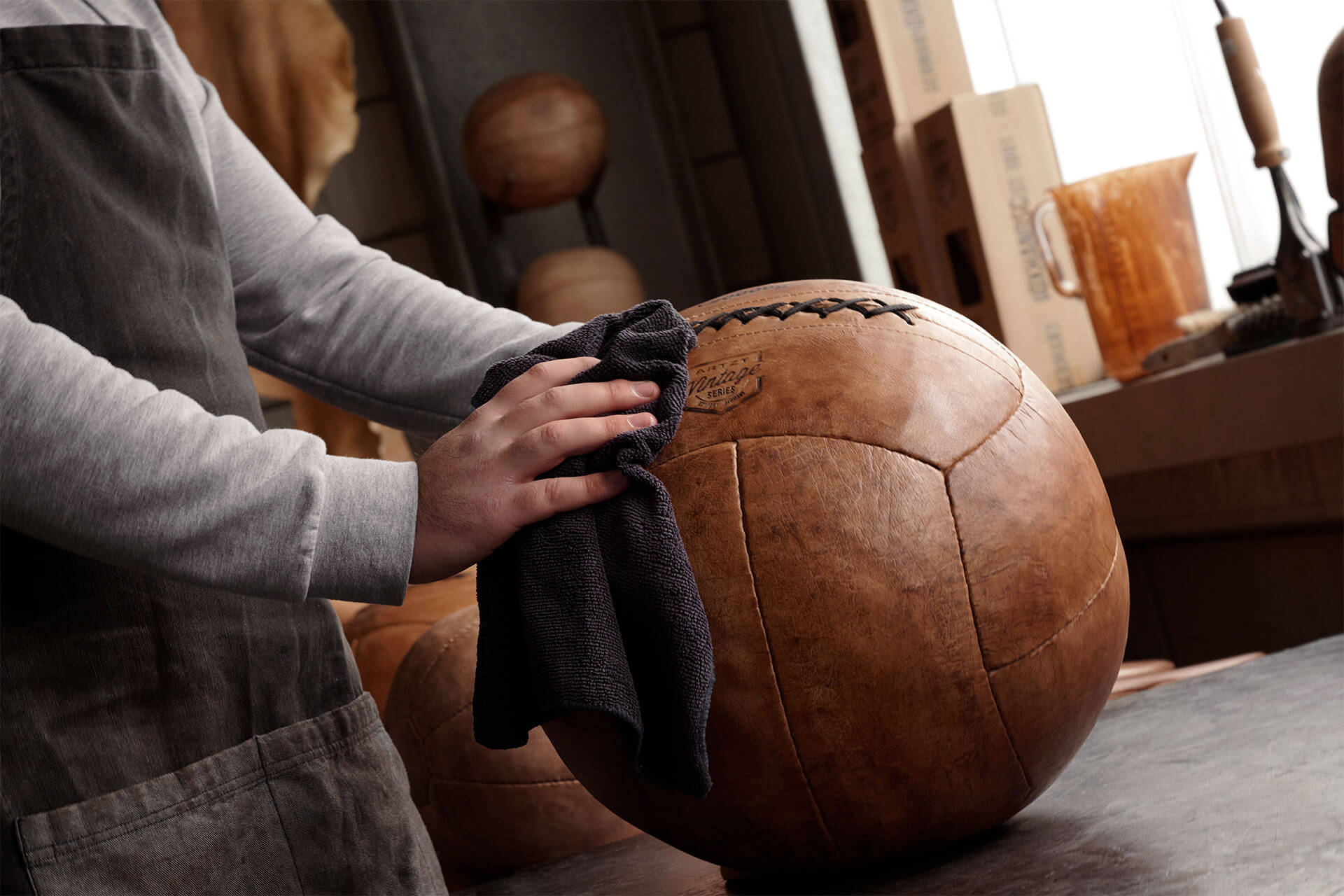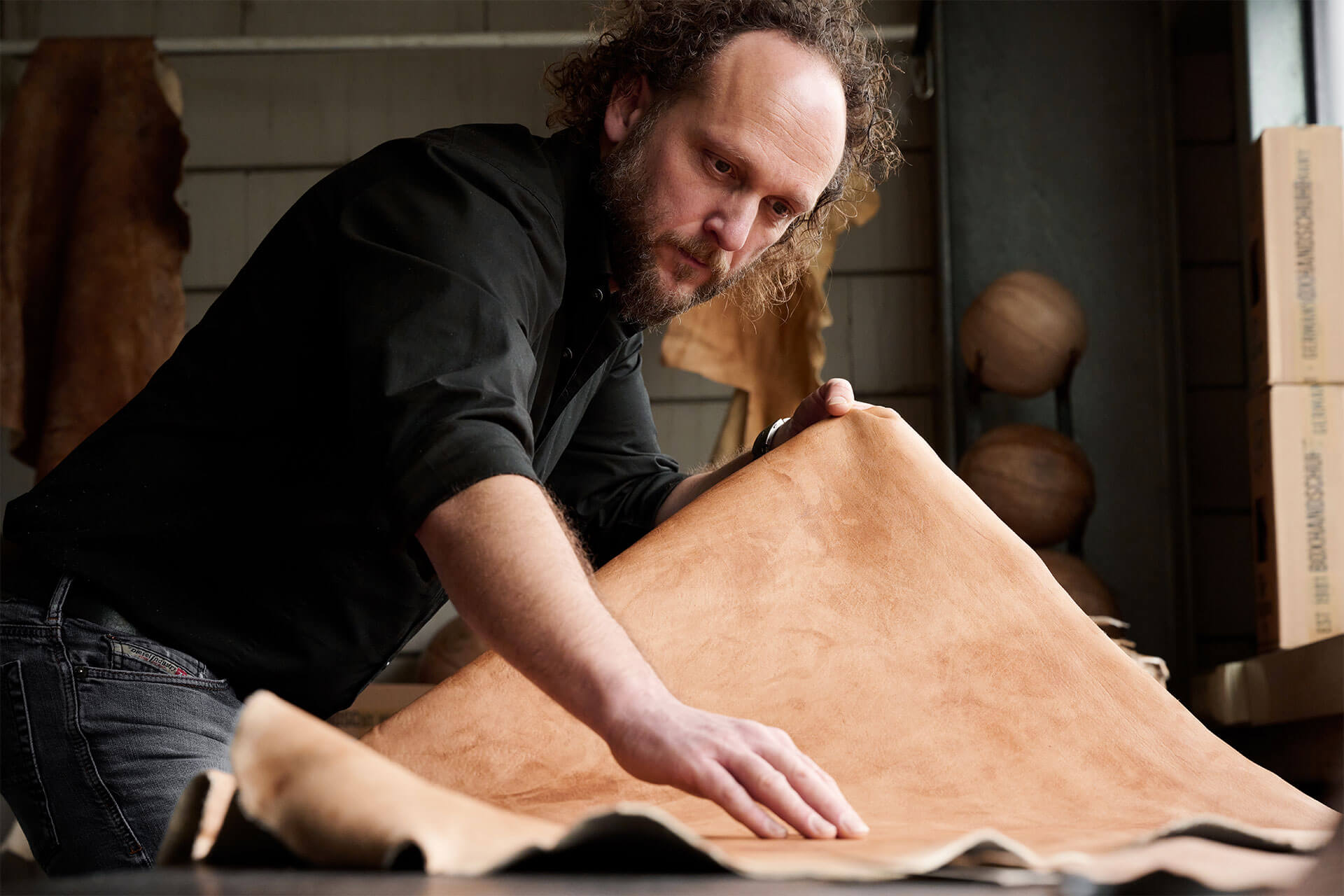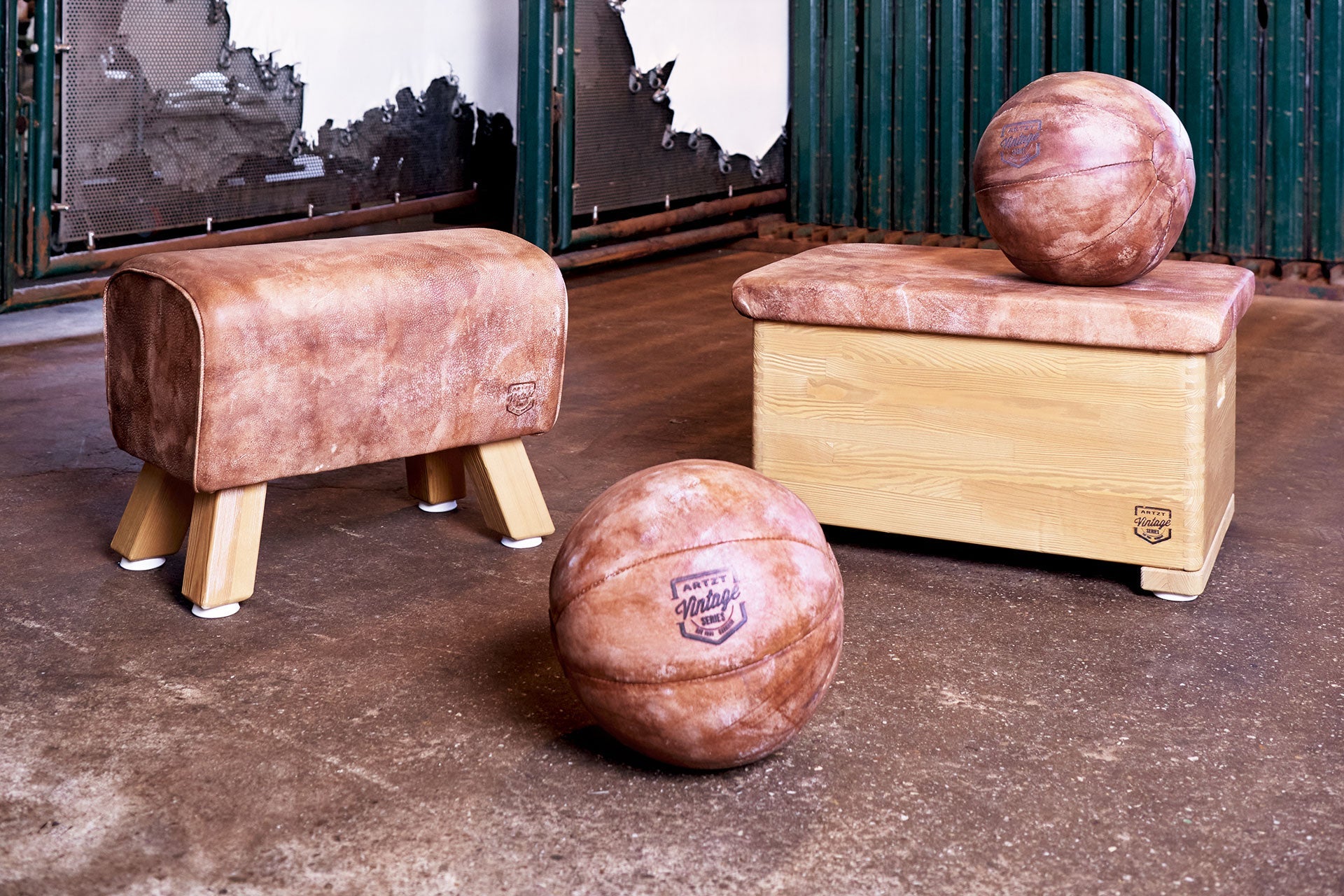
Leather - cleaning and care
Reading time: 7 minutes
Regular training, sweat, cosmetic residue, sebum and even sunlight take a heavy toll on all types of leather. This natural product is durable and undemanding, but it does need a little care now and then to remain attractive and functional for many years.
Contents
What is leather?
What is synthetic leather?
Is leather sustainable?
How is leather produced?
What are the advantages of genuine leather?
How to clean leather properly
Cleaning leather: care and preservation
Leather care: How to properly prevent new soiling and mold
How do I properly care for the leather of the ARTZT Vintage Series?
What is leather?
Equipment for sports and training is expensive and those who maintain their equipment regularly will save a lot of money in the long run and extend the life of their training equipment.
Leather, as a natural product, requires a certain amount of care in order to maintain its positive properties - just like human skin. So get the leather soap and suitable care products! Whether it's a classy sports bag made of smooth leather, leather-covered dumbbell handles made of nubuck or suede, or fitness equipment made of oiled leather in a vintage style - there are individual care rituals for all types of leather.
What is synthetic leather?
The question of which leather is better, artificial or real, is not easy to answer anyway, because quality plays a decisive role in the use. And there is both cheap artificial leather and real leather produced under inhumane and environmentally damaging conditions.
Artificial leather consists of a layer of fabric onto which a plastic membrane with a leather look is applied.
Cheap artificial leather products have a high environmental impact, firstly because of their production and the petroleum-based ingredients, and secondly because they usually have a very limited lifespan and therefore sooner rather than later end up as plastic waste in the dump or even in the sea. The feel and appearance often leave a lot to be desired and after intensive use, the plastic coating wears off the fabric and the product becomes unusable.
Yes, there is now also plant-based artificial leather. But the use of petroleum for the plastic coating in most plant-based artificial leathers also represents a negative for the environmental balance. There are also plant-based imitation leathers such as cork leather and mushroom leather that do not require a plastic coating, but their properties are very different from those of real leather, they are less durable and can therefore only replace it to a very limited extent.
Is leather sustainable?
As long as people eat meat, there will be real leather, because the raw material for it is automatically produced with every animal that is slaughtered. If the animal skin is not processed into leather, it ends up in the garbage. From a sustainability perspective, this is actually a waste, because if the animal is slaughtered, it should be processed as completely as possible in a useful way. It couldn't be more sustainable.
How is leather produced?
The animal skin only becomes leather through the time-consuming and complex process of tanning. The tanning process is crucial for how environmentally friendly the production of the leather is. Today, there are both vegetable and chrome tanning processes with which genuine leather can be produced in an environmentally friendly way.
Although genuine leather is complex to produce, high-quality leather produces a sustainable natural product with a unique character.
What are the advantages of genuine leather?
Real leather, such as elaborately manufactured and refined cowhide, is abrasion-resistant and extremely durable, as well as very long-lasting. And therefore sustainable too! Compared to artificial leather, which is nowhere near as long-lasting as real leather, high-quality leather is also more environmentally friendly to produce.
With proper care, durable cowhide remains ready for use for many years and decades and can even be passed on to the next generation - this is proven by thousands of gymnastic equipment from the time of Father Jahn that is still in use.
How to clean leather properly
Of course, visual accents on almost natural rough, nubuck or vintage leather are what make genuine leather so attractive, but it is also clear that leather as a natural product – similar to human skin – requires a certain amount of care in order to maintain its positive properties.
Before you start caring for the leather, you should first clean it thoroughly, because without cleaning, dirt, dust and salts from sweat during training as well as sebum from oiling and greasing would penetrate the leather and cause it to decompose over time. Mildew and mold also like to grow on dirty leather that is used or stored in a damp environment.
Dirt in seams and gaps attracts moisture, and these are the areas where cleaning should be done more frequently to avoid mildew and mold. Regular dusting is therefore just as important as providing the leather with oils and grease. This can be done with a soft brush and, in hard-to-reach places, with a narrow vacuum cleaner nozzle or brush. An insider tip from a leather expert: dust can be removed very well from particularly fine seams using compressed air from a compressor. But special mini attachments for a normal vacuum cleaner also work perfectly for cleaning corners, edges or seams, etc.
After dusting, the open-pored leather is rubbed with a damp – not wet! – microfiber cloth. After drying, the leather can be carefully roughened again using a very fine steel or rubber brush.
Extra tip: If the dust is already stuck in a seam, you can try your luck with an electric (ultrasonic) toothbrush. If used dry, of course, it is usually possible to remove even stubborn dust crusts.

Soap is not good for every leather
After dusting, smooth leather is cleaned with a high-quality saddle or leather soap. The soap is lathered up with a little water using a soft sponge and then applied to the leather. Any dirt and sweat that clings to the leather, i.e. everything that makes the leather particularly dirty and therefore wears it out, is loosened in this way and can be removed and wiped away with the sponge in a second "wash cycle". The foam from the saddle soap is then allowed to work for a moment until it has dried slightly and is then rubbed off with a soft cloth. The dirt-soap mixture should not dry out completely, so treat larger leather areas piece by piece.
Suede and nubuck leather and also the specially refined open-pored cowhide of the Artzt Vintage Series products do not like saddle or leather soap. Rough, open-pored leather sticks and becomes smooth when treated with a sponge and saddle soap, thereby losing its unique feel and appearance.
These types of leather are rubbed thoroughly with a damp microfiber cloth without any additional additives - if in doubt, change the cloth more frequently if it is very dirty or rinse it and then wring it out vigorously.
Dark spots on light leather?Under no circumstances should you use dirt erasers, as is sometimes described in various forums. These are made from melamine resins and damage the leather with each use by roughening it and thus destroying the surface. In this case, you should use a good, conventional leather cleaner from a specialist retailer. |
Cleaning leather: care and preservation
After cleaning with soap, smooth leather must also be allowed to dry thoroughly. The same applies to types of leather that have been wiped with a damp cloth, such as the high-quality cowhide leather used in the ARTZT Vintage Series fitness tools. It is best to store the leather overnight in a dry, not too warm place (not near the heater!), where any remaining moisture can escape easily.
Under no circumstances should leather be allowed to dry in sunlight! In general, even with good care, leather becomes brittle and dries out when exposed to UV radiation, which is why leather items should generally not be exposed to the blazing sun for longer than necessary.
Once the leather is thoroughly dried, you can proceed with further care if necessary. The use of oils and fats causes suede and nubuck leather to become greasy and smooth, which is usually not desirable. To roughen it up again after cleaning, brush it with a special rubber suede brush. However, all suede and nubuck leather becomes "greasy" over time and with use. Then it can be treated like any other open-pored leather - but with the result that the rough effect gradually disappears.
All smooth, open-pored leather surfaces can be oiled or greased. It goes without saying that, depending on the leather and the level of wear and tear, high-quality oils or high-quality fats and care products based on beeswax are used. If you use oil, you can use special leather oils or high-quality vegetable oils. Peanut oil is an insider tip here.
However, you should be extremely sparing with oils: if applied too thickly, they make the leather spongy and too soft, which is undesirable, especially in the sports and fitness sector, and leads to a loss of use.
While oil penetrates quickly and deeply into the leather, but offers no protection against moisture and wetness, high-quality beeswax-based leather care products, such as various combination products on the market, form a protective film on the leather surface that largely prevents moisture from penetrating the leather.
Light-colored natural leather in particular darkens considerably when oiled, which is why natural-colored leather items should generally be treated with beeswax-based care products.
materials scienceSuede leather - also known as suede, nubuck or rough leather - is the general term for all types of leather that have been sanded on the flesh side of the animal's hide. Suede leather can come from almost any animal and is used for any purpose. It can be made from the side of the hide that is not furry (split leather) or from smooth leather that has been sanded on the grain side. The sanded leather types are very soft and supple, but much more susceptible to dirt than smooth leather. Over time, heavily used suede often becomes greasy, but this can give it a very special look. Smooth leather is made from the animal's former fur side and can be grained, embossed, smooth and structured. Surface-dyed smooth leather is covered by a layer of color and is less sensitive to stains and drying out, but often feels artificial. Open-pore dyed leather has different properties depending on its thickness. It feels warm and soft, but is more susceptible to stains and dries out more quickly. Oiled leather has a very special character. It is supple, but matte in appearance and develops a beautiful patina over time. This leather is coated with a colored layer of fat or wax on the surface. This makes the leather darker and slightly irregular in color. You can tell from oiled leather that light marks can be made with a fingernail. They disappear again after polishing. |
How to properly prevent new contamination and mold
Once all the leather parts are clean and well cared for, the question naturally arises as to how to maintain this condition for as long as possible. This is not easy when you use them daily and train hard. Medicine balls and the like in particular can quickly get dirty on the leather if they are not stored in a dry, airy place. If you want to be on the safe side, rub the leather with a terry cloth towel after training if it is subjected to heavy use and air out the training room well. The following applies to leather sports bags: after sports, remove all damp items such as clothes, shoes and towels and store the bag in a dry place until the next time you use it.
How do I properly care for the leather of the ARTZT Vintage Series?
The classic fitness tools of the ARTZT Vintage Series, as well as the leather of the bench, horse and box, are made of high-quality, specially hand-finished, open-pored cowhide. The daily use of these items in particular helps to enhance the individual look of the classics and maintain the desired appearance. However, the care rituals described above must also be carried out here.
Anyone who regularly uses a damp microfiber cloth and rubs a thin layer of high-quality vegetable oil into the cloth after drying it will be able to enjoy the products for many years, if not decades.


